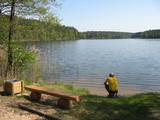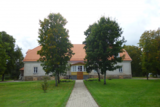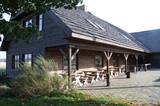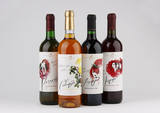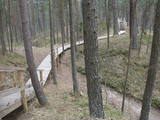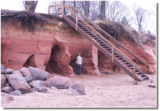| Nr | Name | Beschreibung |
|---|---|---|
|
Das Ferienhaus Surfhunt befindet sich nur 100 m vom Sandstrand der Bucht von Riga und 70 km von Pärnu entfernt. Das Ferienhaus ist für Familien und Freundeskreise geeignet, die in der Natur wandern oder Freizeit aktiv verbringen, zum Beispiel Surfen, möchten. Besonders an diesem Ort ist, dass Gäste selbst Körbe nehmen und auf das Feld gehen können, um aus der Ernte selbst ihre Mahlzeit zuzubereiten. |
||
|
Das Wirtshaus befindet sich im Zentrum von Salacgriva: auf dem Platz des Bootsmanns, am Fluss Salaca. Das früher sehr bekannte Wirtshaus Pie Bocmaņa hat eine neue Innenausstattung über das Thema Münchhausen erhalten. Lettische Küche: Heringssalat, Hering mit Quark, Fischsuppe, Schweinebrust mit Zwiebeln, graue Erbsen mit Speck, gebratene Leber, gebratene Flunder, gebratenes Zanderfilet, geschichtetes Roggenbrot-Dessert. |
||
|
Die zentrale und auch schönste Straße in Trakai mit bunten Holzhäusern. Eins der seltenen Kenesa-Gebetshäuser der Welt – ein eingeschossiges Holzhaus mit einem bläulichen Dach. |
||
|
Das Ziel dieses Territoriums besteht im Schutz der natürlichen und kulturellen Landschaften im Gebiet des Oberen Flusstals der Daugava, wo es eine große biologische Vielfalt gibt. Naturpfade und Fahrradrouten wurden im Naturpark eingerichtet. Der Fluss ist auch für Bootstouren geeignet. Die Flusswindungen im Daugava – Naturpark sind Teil dieses Territoriums (siehe “Naturparks”).
|
||
|
Das Herrenhaus in Ance wurde als Geschenk des Vaters an seinen Sohn Ulrich Johann von Baehr errichtet. Neben dem Herrenhaus wurde ein prächtiger französischer Garten angelegt. Nach 1766 wurde das Gebäude umgebaut und prunkvoll dekoriert. Zu Beginn des 19. Jahrhunderts wurden französische Truppen in dem Gut einquartiert und das Herrenhaus geplündert. Einige Zeit später wurde die zweite Etage abgerissen und nach langer Reparatur wurde das Gebäude umgewidmet als Wohnhaus für den Gemeindevorsteher und weitere Beamte. 1920 wurde der Gutshof Ance verstaatlicht. |
||
|
The steep shores of Jūrkalne are one of the most popular tourist destinations in Kurzeme. The shores are up to 20 m high, washed by the waves and mostly made of sand and narrow bands of pebbles and stones. Opposite the centre of Jūrkalne is a viewing platform and a set of stairs that lead to the sea. The shore continues in the direction of Pāvilosta and Ventspils. |
||
|
Tūrisma gide Ineta Jansone piedāvā ekskursijas grupām uz Ķemeriem un iepazīstina ar Ķemeru kūrorta vēsturi. Kopš seniem laikiem Ķemeri slaveni ar to, ka šeit ir daudz sērūdeņu avotu un ārstnieciskās dūņas. Šurp brauca ārstēties kopš 19. gs. sākuma. 1838. gadā Ķemeros nodibināja kūrortu. Ķemeru kūrortā ārstēja ādas un kaulu slimības, kā arī gremošanas un nervu sistēmas slimības. 1877.g. izbūvēja dzelzceļa līniju Rīga - Tukums, bet 20.gs. sākumā tika ieviesta tiešā dzelzceļa satiksme ar Maskavu. Kūrorts bija ļoti populārs un katru gadu arvien vairāk viesu brauca šurp ārstēties. Īsi pirms I Pasaules kara atklāja elektriskā tramvaja satiksmi starp Ķemeriem un jūru - Jaunķemeriem. Ķemeri atrodas starp purviem un ezeriem, 6 km attālumā no Rīgas jūras līča. |
||
|
This park is located in the northern part of the Žemaitija Highlands, and much of it is taken up by Lake Plateliai. The park was established to protect lakes, rivers, wetlands and forest ecosystems, as well as the local cultural environment.
|
||
|
Dieses Wirtshaus befindet sich einige Kilometer von Jurkalne entfernt: in einem Blockhaus mit lettischer Innenausstattung. Hier werden Konditoreiwaren hergestellt. Das Wirtshaus arbeitet mit Heimarbeitern zusammen. Lettische Küche: Nesselsuppe mit Gänseeiern, Suppe aus Ostseefischen, graue Erbsen mit geräuchertem Schinken, Kartoffelpfannkuchen mit Lachs, Hering mit Quark, hausgemachte Frikadellen, geschmorte Schweinerippen, Festbraten mit Herbstbeeren, Rindfleisch mit Pfifferlingsoße, Wildschweinfrikadellen, gebratenes Kabeljau- oder Zanderfilet, geschichtetes Roggenbrot-Dessert, Birkensäfte, Johannisbeerensaft. Das besondere Gericht: Im Wirtshaus gekochte Nudelteigtaschen mit Fleisch. |
||
|
In einem kleinen Betrieb werden aus lokalen Produkten und ohne Konservierungsstoffe hausgemachte Weine, interessante Liköre, Marmeladen, Obst- und Beerenkonfitüren hergestellt. Die Produkte werden zum Kauf angeboten. |
||
|
Der Naturpark im Ort von Jūrmala wurde eingerichtet, um die Dünen, den Kiefernwald und den Küstenlebensraum zu schützen. Der Park bietet einen der attraktivsten Naturpfade im Rigenser Gebiet. Er befindet sich in der Nähe der bekannten Ragakāpa-Düne, die teilweise bis zu 17 m hoch ist. Das ist eine ausgezeichnete Möglichkeit, den Dünenlebensraum und seine Pflanzen, Vögel, Insekten usw., die hier leben, zu schützen. Man kann auch Kiefern sehen, die 100 Jahre und älter sind.
|
||
|
Die Gaststätte in einem Holzblockhaus am Stadtrand von Sigulda ermöglicht es, den lettischen Geist im Inneren zu verspüren und lettische Gerichte zu genießen. Die Traditionen und die Qualität der lettischen Kochkunst sind in der Gaststätte erhalten gebleiben Lettische Küche: Sauerkrautsuppe, Zanderfilet, Hechtfrikadellen, Schweinezunge, Schweinerippen, hausgemachte Frikadellen, Kartoffelpfannkuchen, geschichtetes Roggenbrot-Dessert, im Honig gebackenes Roggenbrot, gebackener Apfel, hausgemachtes Eis. Das besondere Gericht: Steak nach dem Geschmack von "Bucefāls", Eis nach dem Geschmack von "Bucefāls". |
||
|
Das Museum wurde 2007 eröffnet. In der Exposition sind ein 180 mm Kanonenrohr, Rekonstruktion der Staatsgrenze, Zivilschutzräume, Panzerwagen, Grenzüberwachungsboot, Meeresminen. Im Hauptgebäude wird Beobachtungsradar, Waffenabstellraum, Kasernenmilieu und andere thematische Gegenstände präsentiert. |
||
|
The viewing tower is in the southern part of the reserve, along the Ļaudona-Mārciena road and on the Madona-Trepe embankment. Here you can view a very wide territory all the way to the Vidzeme highlands, including Gaiziņkalns Hill if the weather is clear. At the foot of the tower you will see the lakes known as Small and Great Lake Plencis. |
||
|
Dieser Bereich des Baltischen Küstenwanderwegs ist für abgehärtete Wanderer geeignet, denen es gefällt, durch unbewohnte Orte zu reisen. An vielen Stellen erstrecken sich auf der estnischen Küste Schilfe, Auen mit Weiden und Feuchtgebieten. Die Route führt Sie deshalb oft über Wald- und Landwege. In der zweiten Hälfte des Sommers kann man in den Küstenwäldern Pilze und Beeren sammeln. Pärnu ist eine beliebte Kurstadt mit vielen Cafés, Live-Musik, SPAs, Hotels und einer schönen Altstadt. |
||
|
The brothers Imants and Ivars Novožilovs have spent more than 10 years collecting local evidence of World War II – weapons, wrecks of armoured vehicles, the everyday objects of soldiers, etc., and they have now opened an exhibition of those items at the former headquarters of the local parish council.
|
||
|
Ainavisks jūras viļņu izskalots smilšakmens atsegums
dienvidos no Zaķupes ietekas.
|
||
|
Das Landgut von Krimulda (deutsch Cremon) ist in den schriftlichen Quellen zum ersten Mal schon im 15. Jh. erwähnt worden. Das heutige Schloss von Krimulda erhebt sich prachtvoll gegenüber der Luftseilbahn von Sigulda auf dem Hang des rechten Grundufers des Urstromtales von Gauja. Sowohl auf das Schloss (vom anderen Ufer und von der Luftseilbahn), als auch aus dem Schloss eröffnet sich eine wunderschöne Aussicht auf das Urstromtal des Flusses Gauja. Das Schloss von Krimulda wurde im 19. Jh. im Neoklassizismus gebaut und sein Inhaber war der Fürst Lieven. In den 1920er Jahren gelang das Schloss nach der Enteignung im Eigentum des Lettischen Roten Kreuzes, das dort ein Sanatorium für Kinder eingerichtet hat. Heute befindet sich in diesem Schloss das Rehabilitationskrankenhaus Krimulda, aber von den wirtschaftlichen Gebäuden des Landgutes haben sich die Ställe, das Haus der Diener und der Verwalter und das sogenannte Haus der Schweiz erhalten. Im Landgut von Krimulda werden Führungen organisiert und hier kann man auch übernachten. |
||
|
Das Schloss befindet sich in Krustpils, in der Rīgas Straße 216 b. Die Anfänge des Schlosses sind im Jahr 1237 zu suchen. Damals hat der Bischof von Riga Nikolai aus Magdeburg die Burg von Krustpils gebaut, die die erste befestigte Burg der Kreuzritter in der Region Latgale war. Vom Ende des 16. Jhs. bis zum Anfang des 20. Jhs. gehörte das Schloss dem Ritter Nikolai Korff (und seiner Familie). Das Schloss hat mehrmals unter Kriegen gelitten und ist umgebaut worden, aber trotzdem hat es bis heute seinen eingeschlossenen Hof erhalten, der den mittelalterlichen Burgen charakteristisch war. Mitte des 19. Jhs. bekommt das Schloss die heutige Innenausstattung des Historismus, aber es haben sich auch Elemente der älteren Bebauung erhalten: der Torturm, Hauptwände, Schießluken, Gewölbekonstruktionen, Fensternischen u.a. Während der Sowjetzeit befand sich in dem Schloss die Sowjetarmee, aber neben dem Schloss wurde die sogenannte Kriegsstadt eingerichtet, die heute Pils rajons (der Bezirk des Schlosses) genannt und der von der westlichen Seite von dem Teich Pils dīķis (Teich des Schlosses) eingeschlossen wird. Im Jahr 1994 wurde in dem Schloss das Geschichtsmuseum von Jēkabpils eingerichtet, das man unter der Leitung eines Reiseleiters oder individuell besichtigen kann. Zurzeit ist das Schloss eine der wenigen Sehenswürdigkeiten in Lettland, die man mit Hilfe eines Audio-Reiseführers kennenlernen kann. Von dem Schlossturm bietet sich eine schöne Aussicht. |
||
|
Iespēja patīkamā atmosfērā baudīt ļoti gardu ēdienu. . Starp tiem arī Lietuviešu tradicionālo ēdienu. Ir dienas un vakara īpašie piedāvājumi. |
||




